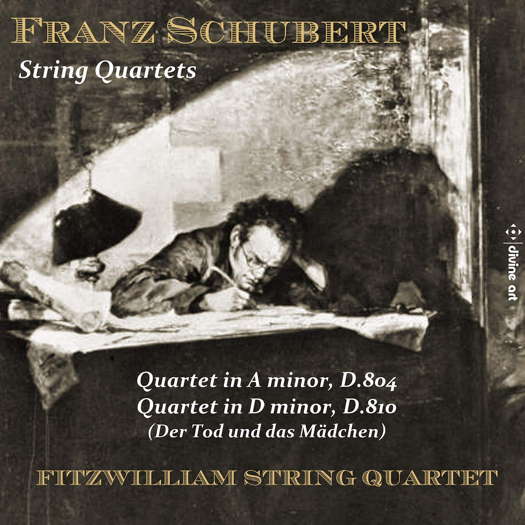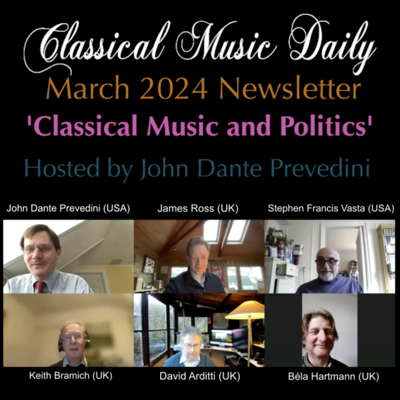 FEEDBACK: She said WHAT? Read what people think about our Classical Music Daily features, and have your say!
FEEDBACK: She said WHAT? Read what people think about our Classical Music Daily features, and have your say!

Hallmarks of a Troubled Mindset
PATRICK MAXWELL listens critically to the Fitzwilliam String Quartet's Schubert
'This CD holds within some extremely heart-rending, joyous and emotionally infused music, played by some wonderful individual players.'
Schubert's musical world is perhaps one of the most distinctly Romantic of any of his nineteenth-century contemporaries; to peruse one of his scores is to be set upon some of the most impassioned and key-dominated work, built with a simplicity of harmony which so often evokes the spirit of Caspar David Friedrich's famous Wanderer, which can speak of a heartfelt mix of joy and melancholia. It could be said that he was plagued by Beethoven's shadow, and famously (although only purportedly) asked how anyone could achieve real musical greatness after the former's death in 1827. Their musical difference stems often from Schubert's love of chamber music, and his quest for a sound that spoke more evidently of the pastoral and yearning (although often cliché-ridden) poetry of Müller, Heine and Rellstab (all writing under the shadow of Schiller), which can be seen in some of the works of Schumann and others after him.
All of this seems to have been realised by the players of the Fitzwilliam Quartet, in this new recording of two of his most well-known string quartets. Yet the effect is not as impressive, as wholesome, as can be gained from the works they perform here; there is not the overall variety needed to interpret these works. Schubert, not just in his string works, can seem repetitive, the same figures, emotional standpoints given multiple times, and his ability to flow between sections not as ornate or unseemly as Beethoven's, often employing the simple chord progressions to change sections. There is most certainly a range of tones and expressions in this recording, and an impressive mix of the different instruments to create a polyphony in the more tempestuous sections, yet a monotonousness is sometimes found that is unwanted in trying to get the music away from its bare manuscript and into the emotional arena that Schubert was so enveloped in, and to keep the music constantly changing in effects.
The first quartet in this collection is the Quartet in A minor, D 804 from 1824. The first movement has a deep, intensely morose feel which is evident from the very start in the falling A minor triad in the first violin and the searching accompaniment in the second.
Listen — Schubert: Allegro ma non troppo (Quartet in A minor, D 804)
(track 1, 0:02-0:46) © 2020 Divine Art Limited :
The key shifts quickly between the minor and major, as the overall tone does equally swiftly between moods of lyricism and contemplation and the 'angry abruptness and severity', as violist Alan George describes it in his informative but often inanely written notes. (I am reviewing the music here, but the quality of writing of the programme notes is important, especially when there is an evident wish of the Quartet to provide context for their interpretations, and the style of these notes is at points meretriciously weak.) That tendency for musical severity and surprising changes into musically violent emotion is a theme of this first movement, and the need for maturity in approaching the different points in the music is often missing, leaving the effect to be diminished when repeated many times. The lack of variation hinders the opportunity to give a new perspective on Schubert's score, which, although bearing the hallmarks of the troubled mindset he was in at the time of composition, does have the need for a more measured approach, in order to make the at times repetitive music still seem vivacious enough by the end of the long first movement.
The second movement, it is true, allows more easily for the more measured and accumulative music-making which the most expressive overall effect demands. The key of C major allows more for a simpler and more evocative yearning, or perhaps simply a constant search for meaning, resolution, which is fulfilled by the contrast of the same kind of at times dense, entrenched chords, and then sparse and flowing music, led by the admirably expressive Lucy Russell as the leader, who maintains her simple melody under the semi-quaver runs of the second violinist Marcus Barcham Stevens. This music is markedly less troubled and vertiginous, although the cellist Sally Pendlebury does use her Giovanni Regeri instrument, of circa 1700, and the gut strings used by all players to enhance this effect and keep the threatening undertones pronounced.
Listen — Schubert: Andante (Quartet in A minor, D 804)
(track 2, 0:00-0:54) © 2020 Divine Art Limited :
The third movement begins with low murmurings on the cello which seem to be foreboding premonitions, before Schubert launches into another ascending melody that switches between the same keys of C major and A minor. The trio that follows starts in a relaxed A major before variations lead it to a conciliatory imperfect cadence in E major.
The last movement possesses a much more jaunty and folk-song nature to it, using the effect of semi-quaver turns to their full effect, along with an ingenious and characteristic ability to create musical panoplies built around the same melody, seeming to grow upon each other at each point in the music.
The Quartet in D minor, D 810, is often cited as one of the most extraordinary works not just of Schubert's incredibly broad oeuvre, but of the string quartet repertoire and Romantic music as a whole. The nickname Der Tod und das Mädchen has caught on more than the Rosamunde title ever has for the A minor. Well, it's a better name, and one that speaks clearly of the masterful grasp of key, structure and motif that is never in such abundance in the previous work. If there was a slightly nihilist backstory to the above Quartet, then the D minor is the irate, almost Beethoven-esque pinnacle of Schubert's chamber works; deeper than The Trout, more exploratory and varied, than many of his songs, especially the often trudging music that makes up much of Die Winterreise. Of course, there is the immediate context of Schubert's life; he had recently been severely and was now acutely aware that death was near, that the illness that had been chasing for so long was now close to catching him, and at the height of his powers.
It would be a desultory cliché to say that this music 'has it all', but there is such a broad mixture of technical prowess in this work; the compulsive motif of the open D minor chord, the moments of desolation, ecstasy, passionate yearning, and the unsure, deeply Romantic scenes, such as the chord right at the beginning, which seems a simple tonic G minor chord, but with a simple, persistent F in the viola; calm uncertainty, calling to mind the tale of Turner dabbing a miniscule point of bright orange to his sea landscape, transforming the effect. Schubert's reliance on chord structures is still here, but the originality and brilliance more evident than ever before, the stream of consciousness that must have created much of his work at such a fast pace more vivid and altogether more energetic.
Listen — Schubert: Allegro (Quartet in D minor, D 810)
(track 5, 5:25-6:19) © 2020 Divine Art Limited :
The almost hymn-like, hypnotic beginning of the second movement, Andante con moto, is carried off here with a delicacy of tone by the players, with the space for more building-up of the music. This sense again could have been increased by more of an overall assurity of cohesive structure, although much of the individual playing is often of the highest and most evocative calibre.
Listen — Schubert: Andante con moto (Quartet in D minor, D 810)
(track 6, 0:00-0:58) © 2020 Divine Art Limited :
There is an intensity and central sense of direction which moves it forwards through different melodies, mixed with a variety of techniques and ideas: high violin melodies and idiosyncratic, ornate details, arpeggiated cello pizzicatos, making each section of the long movement unique while also maintaining a sense of the overall structure and forward momentum.
The short, more volatile Scherzo in a sprightly A major, leading into the final movement, which starts with a boisterous D minor melody, again returning to the tonic and dominant of the key for the most direct expression, although the dominant emotion here is more triumphant, although still possessing a vulnerability which masks the potential for darker undertones, finally covered over by the urgency of the stark ending in the tonic, on the most impassioned perfect cadence.
Listen — Schubert: Presto - Prestissimo (Quartet in D minor, D 810)
(track 8, 8:52-9:50) © 2020 Divine Art Limited :
Playing on period instruments is always welcome, and often necessary, in order for musicians to render the most complete sound which can interpret the composer's original experiences and intentions properly. Yet what was missing from the playing in this collection was the immersion and passion needed to interpret Schubert's score to another peak, to see the different peaks and troughs that can be interpreted differently in the score, although the different expressions and sections are seemingly simplistic at times. This CD holds within some extremely heart-rending, joyous and emotionally infused music, played by some wonderful individual players. The overall sounds required more forethought and mobilisation to achieve the most engrossing effect that Schubert's music can.
Copyright © 14 September 2020
Patrick Maxwell,
Buckinghamshire, UK

CD INFORMATION - SCHUBERT: STRING QUARTETS - FITZWILLIAM QUARTET
FURTHER INFORMATION: FRANZ SCHUBERT
FURTHER INFORMATION: DIVINE ART LTD
FURTHER ARTICLES ABOUT STRING QUARTETS



